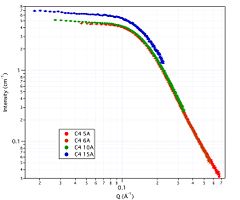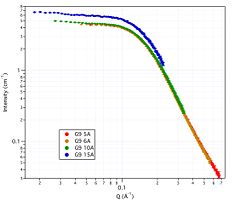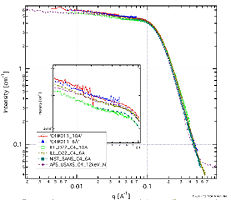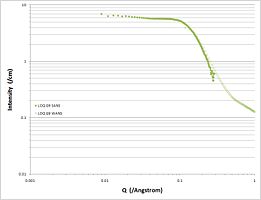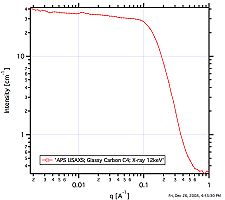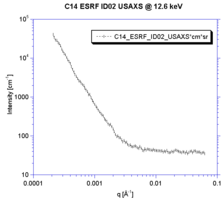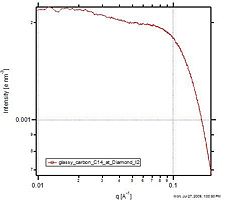Glassy Carbon Round Robin: Difference between revisions
(→ILL) |
AdrianRennie (talk | contribs) No edit summary |
||
| (7 intermediate revisions by 3 users not shown) | |||
| Line 2: | Line 2: | ||
Two samples of glassy carbons (labeled C4 and G9) from Jan Ilavsky have made their way (as of Dec 1 2008) to NIST, ILL and ISIS and will head on to Diamond and APS. Additionally another sample, labeled G8, has been measured at ISIS. | Two samples of glassy carbons (labeled C4 and G9) from Jan Ilavsky have made their way (as of Dec 1 2008) to NIST, ILL and ISIS and will head on to Diamond and APS. Additionally another sample, labeled G8, has been measured at ISIS. | ||
The samples are cut from glassy carbon material, manufactured by Alpha Aesar under description: Glassy Carbon type 2. These samples are manufactured in 50 x 50 mm plates, nominally 1 mm thick. Measurements with a micrometer were all between 0.99 and 1.01 mm | The samples are cut from glassy carbon material, manufactured by Alpha Aesar under description: Glassy Carbon type 2. These samples are manufactured in 50 x 50 mm plates, nominally 1 mm thick. Measurements with a micrometer were all between 0.99 and 1.01 mm. The following reference describes the type of material that has been used for this round-robin and some X-ray scattering results: | ||
Fan Zhang, Jan Ilavsky, Gabrielle G. Long, John P.G. Quintana, | |||
Andrew J. Allen, and Pete R. Jemian, “Glassy Carbon as an Absolute Intensity Calibration Standard for Small-Angle Scattering”, Metallurgical and Materials Transactions A DOI: 10.1007/s11661-009-9950-x | |||
==Data Format== | |||
Contributors are encouraged to deposit their data using the | Contributors are encouraged to deposit their data using the | ||
[[cansas1d_documentation | cansas1d/1.0 XML data standard for 1-D SAS data]] within a ZIP or gzip archive file. Include the default XSLT stylesheet ([http://svn.smallangles.net/svn/canSAS/1dwg/trunk/cansasxml-html.xsl cansasxml-html.xsl]) in the archive and make sure that each XML file has a reference to that stylesheet in the file header: | [[cansas1d_documentation | cansas1d/1.0 XML data standard for 1-D SAS data]] within a ZIP or gzip archive file. | ||
A WWW form ([http://www.smallangles.net/canSAS/xmlWriter/ canSAS/xmlWriter]) | |||
is available to translate three-column ASCII text data into the | |||
canSAS1d/1.0 XML format. | |||
Include the default XSLT stylesheet ([http://svn.smallangles.net/svn/canSAS/1dwg/trunk/cansasxml-html.xsl cansasxml-html.xsl]) in the archive and make sure that each XML file has a reference to that stylesheet in the file header: | |||
<pre> | <pre> | ||
<?xml version="1.0"?> | <?xml version="1.0"?> | ||
<?xml-stylesheet type="text/xsl" href="cansasxml-html.xsl" ?> | <?xml-stylesheet type="text/xsl" href="cansasxml-html.xsl" ?> | ||
<SASroot ... | <SASroot ... | ||
</pre> | |||
==Data Repository== | |||
All the data on this page is available in a subversion repository: | |||
<pre> | |||
svn co http://svn.smallangles.net/svn/canSAS/1dwg/data | |||
</pre> | </pre> | ||
| Line 42: | Line 59: | ||
</Gallery> | </Gallery> | ||
Zip file of | * Data from 2008 should be ignored. Apparently there was an error in the reduction. | ||
Zip file of 2008 data (in NIST 6 column format) with plots in PDF and Igor Pro formats [[Media:GlassyCarbon_ILL.zip|GlassyCarbon_ILL.zip]] | |||
Zip file of | Zip file of 2008 data (in canSAS XML 1D format) [[Media:GlassyCarbon_ILL_XML.zip|GlassyCarbon_ILL_XML.zip]] | ||
===ISIS=== | ===ISIS=== | ||
| Line 91: | Line 110: | ||
The calibration sample measured on ID02 is designated "Glassy Carbon type 2 C, sample C14", thickness 1 mm. | The calibration sample measured on ID02 is designated "Glassy Carbon type 2 C, sample C14", thickness 1 mm. | ||
The scattering intensity has been calibrated with the USAXS camera relative to the primary beam without any | The scattering intensity has been calibrated with the USAXS camera relative to the primary beam without any cross calibration. | ||
cross calibration. | |||
Remark: To increase the resolution at very low q-values a third crystal is mounted perpendicular to the scanning crystals. | Remark: To increase the resolution at very low q-values a third crystal is mounted perpendicular to the scanning crystals. | ||
Latest revision as of 10:59, 20 September 2009
Samples
Two samples of glassy carbons (labeled C4 and G9) from Jan Ilavsky have made their way (as of Dec 1 2008) to NIST, ILL and ISIS and will head on to Diamond and APS. Additionally another sample, labeled G8, has been measured at ISIS.
The samples are cut from glassy carbon material, manufactured by Alpha Aesar under description: Glassy Carbon type 2. These samples are manufactured in 50 x 50 mm plates, nominally 1 mm thick. Measurements with a micrometer were all between 0.99 and 1.01 mm. The following reference describes the type of material that has been used for this round-robin and some X-ray scattering results:
Fan Zhang, Jan Ilavsky, Gabrielle G. Long, John P.G. Quintana, Andrew J. Allen, and Pete R. Jemian, “Glassy Carbon as an Absolute Intensity Calibration Standard for Small-Angle Scattering”, Metallurgical and Materials Transactions A DOI: 10.1007/s11661-009-9950-x
Data Format
Contributors are encouraged to deposit their data using the cansas1d/1.0 XML data standard for 1-D SAS data within a ZIP or gzip archive file. A WWW form (canSAS/xmlWriter) is available to translate three-column ASCII text data into the canSAS1d/1.0 XML format.
Include the default XSLT stylesheet (cansasxml-html.xsl) in the archive and make sure that each XML file has a reference to that stylesheet in the file header:
<?xml version="1.0"?> <?xml-stylesheet type="text/xsl" href="cansasxml-html.xsl" ?> <SASroot ...
Data Repository
All the data on this page is available in a subversion repository:
svn co http://svn.smallangles.net/svn/canSAS/1dwg/data
Experimental details and Data
NIST
- NIST data for C4 and G9
Zip file of all data (in NIST 6 column format) with plots in PDF and Igor Pro formats GlassyCarbon_NIST.zip
Zip file of all data (in canSAS XML 1D format) GlassyCarbon_NIST_XML.zip
ILL
2009 Data
- ILL data for C4 and G9
Zip file of all data (in ILL reduced ascii and canSAS XML) with comparison plot JPEG GlassyCarbon_ILL_Aug09.zip
2008 Data
- ILL data for C4 and G9
- Data from 2008 should be ignored. Apparently there was an error in the reduction.
Zip file of 2008 data (in NIST 6 column format) with plots in PDF and Igor Pro formats GlassyCarbon_ILL.zip
Zip file of 2008 data (in canSAS XML 1D format) GlassyCarbon_ILL_XML.zip
ISIS
- ISIS data for C4 and G9
The collected data in canSAS XML format : GLASSYC_C4G8G9.XML and in pseudo canSAS XML (includes T vs Lambda datasets): GLASSYC_C4G8G9_withTL.XML
Zip archive file with above XML files and standard stylesheet: GLASSYC_C4G8G9.zip
Excel file of that data with plots : Glassy_Carbons_C4_G8_G9.xls
APS USAXS
- APS data for C4 and G9
Zip file of all data (in ASCII 3 column format) with plots in PDF and Igor Pro formats GlassyCarbon_APS.zip
Zip file of all data (in canSAS XML 1D format) GlassyCarbon_APS_XML.zip
ESRF ID01 PINHOLE
The calibration sample measured on ID01 is designated "Glassy Carbon type 2 C, sample C14", thickness 1 mm.
The scattering intensity has been determined by cross calibration with a secondary standard ("lupolen BL4"). The scattering intensity of this sample decreases locally with the absorbed dose where irradiated. The unirradiated parts of this sample have identical scattering intensities that are higher than the scattering intensites of the irradiated parts. The calibration factor was found by scanning the secondary standard and using only an unirradiated part for calibration. Due to the uncertainties of the sample the accuracy of the absolute calibration is not assumed to be better than +-20%. The error bars indicate the statistical errors that are practically neglegible (typically 0.1% of the data values).
- ESRF ID01 PINHOLE data for C14
Zip file of all data (in ASCII 3 column format) GlassyCarbon_ESRF_ID01.zip
ESRF ID02 USAXS
The calibration sample measured on ID02 is designated "Glassy Carbon type 2 C, sample C14", thickness 1 mm. The scattering intensity has been calibrated with the USAXS camera relative to the primary beam without any cross calibration.
Remark: To increase the resolution at very low q-values a third crystal is mounted perpendicular to the scanning crystals. This reduces the sensitivity at higher q-values. Therefore only the range from qmin=0.0002*nm to qmax=0.06*nm has been measured.
- ESRF ID02 USAXS data for C14
Zip file of all data (in ASCII 3 column format) GlassyCarbon_ESRF_ID02.zip
Diamond I22
- DLS I22 SAXS data for C14
SAXS data, 8.9 keV, in canSAS XML format gc14-dls-i22.xml and ZIP archive gc14-dls-i22.zip.
